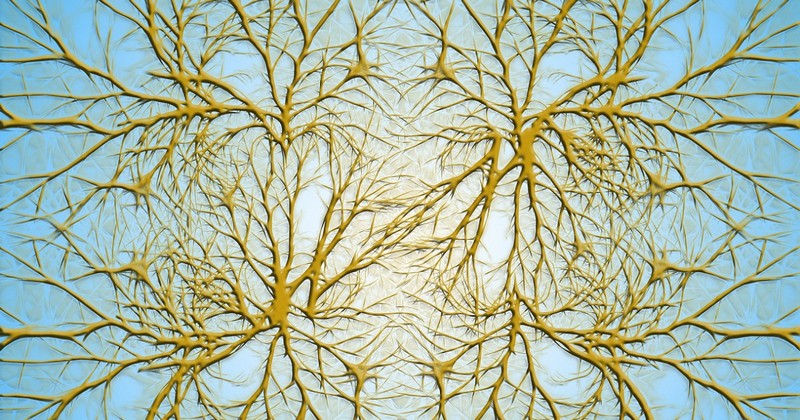What are neuron dendrites?

Thanks to these microscopic ramifications, neurons are able to communicate with each other.
The different parts of neurons tell us a lot about how these tiny brain cells function. brain cells work.
Neuronal axons, for example, with their elongated wire-like shape allow electricity to travel through them, regardless of whether or not they are accompanied by myelin sheaths. Dendrites, in turn, serve another function, which we will now see. which we will now see.
What are dendrites and what is their function?
Dendrites are parts of neurons that are spread throughout the body. are distributed throughout the body, i.e. in the brainThey are found in the brain and the spinal cord as well as in the ganglia, internal organs, muscles, etc.
Specifically, the dendrites are small ramifications that leave the cell body (the part of the neuron in which the cell nucleus is located). Compared to the axon, dendrites are usually shorter and thinner, so that they end closer to the cell body.
In addition, the surface of the dendrites there are still another kind of microscopic prolongations. microscopic extensions. These are small formations called dendritic spines, which are, in turn, short and thinner, so that they end closer to the cell body.which are, in turn, the places where the dendrites perform their main function, as we shall see.
Dendritic spines and synapses
Since the time of the famous Spanish neurologist Santiago Ramón y Cajal, it has been known that neurons are small, relatively independent bodies, i.e., that there is a separation between them. A part of this space that separates the neurons from each other are the so-called synaptic spaces, which are the points through which the synapses are connected.These are the points through which these nerve cells pass information to each other by means of substances called neurotransmitters.
The function of the dendrites in general, and of the dendritic spines in particular, is that of to act as the main contact point for neurotransmitters arriving from the outside. In other words, the dendritic spines act as terminals to which the stimuli from the other neuron that sends neurotransmitters through the synaptic space arrive. Thanks to this, it is possible to establish the transmission of nerve impulses that allows the functioning not only of the brain, but of the entire nervous system, since there are neurons distributed throughout the body.
On the other hand, the brain's potential to adapt to circumstances (for example, by learning from experience) is also possible thanks to the work of the dendrites. It is the dendrites that regulate the possibilities for two nerve cells to come into contact with each other more or less frequently, thus deciding the "route" taken by the nerve impulses.
With the passage of time, the degree of affinity that the dendrites of one neuron gain with the terminals of another neuron a regular communication pathway is created, a fact that affects, albeit minimally, the progress of the mental operations being carried out.This fact affects, even if only minimally, the progress of the mental operations that are being carried out. Of course, this effect multiplied by the number of synapses in the nervous system is not minimal, and not only affects the functioning of the brain and the rest of the system, but is, in itself, the basis of this.
On the surface of the dendritic spines there is a series of structures called receptors that are responsible for capturing certain types of neurotransmitters and activating a specific mechanism.. Thus, a neurotransmitter such as dopamine will reach a receptor compatible with it and cause it to activate a process in the receiving neuron.
Its role in brain communication
If the axons are in charge of making the nerve impulses travel through two points of the nervous system, the dendrites are in charge of capturing the chemical substances that come out from the tip of the axons and of making these chemical signals transform or not into electrical impulses. These chemical signals may or may not be transformed into electrical impulses, although this process can also be initiated by the dendrites.although this process can also be initiated in the body of the neuron.
That is, it is in the dendrites and dendrites and in the neuronal body where the electrical signals (also called action potentials) that are (also called action potentials) that travel through the neurons and will end at the tip of the axons, causing this part of the neuron to release chemicals. When the right amount of neurotransmitters reach the dendrites, depolarization occurs, depolarization occurswhich is the process that generates nerve impulses.
The dendrites are very sensitive to the slightest variations in the type and amount of neurotransmitters they pick up.This means that depending on the chemical substances they detect, they initiate one or another pattern of electrical impulses, or they do not generate an electrical signal at all, if conditions are met.
This means that it is not necessary that the dendrites do not pick up any neurotransmitter in order not to produce an electrical impulse.This can also occur if they pick up a certain amount of a certain type of chemicals. This is why some psychotropic drugs act on the dendrites of neurons, so that they do not generate electrical signals as they would if it were not for the effect of this active ingredient.
In short, the molecular traces that the lived experiences leave in the dendrites and in the terminals of the neurons are the basis of the functioning of the nervous system and its capacity to make its activity vary dynamically. At the same time, they are a fundamental part of the memory management process, which are patterns imprinted in those molecular fingerprints with which the nerve cell works.
(Updated at Apr 13 / 2024)